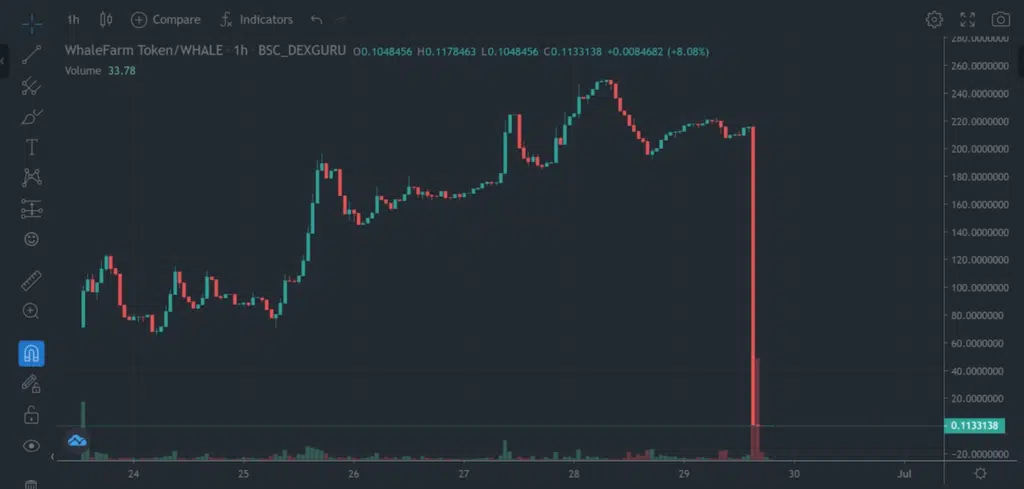Understanding Rug Pulls
A rug pull refers to a malicious tactic employed within the cryptocurrency industry where developers of a crypto project abandon the endeavor, taking investors’ funds with them.
Typically, rug pulls occur in the decentralized finance (DeFi) ecosystem, particularly on decentralized exchanges (DEXs). The process involves creating and listing a token on a DEX, often paired with a popular cryptocurrency like Ethereum.
Rug pulls thrive on DEXs due to their free and unaudited token listing process, which contrasts with centralized cryptocurrency exchanges.
Moreover, creating tokens on open-source blockchain protocols like Ethereum is simple and cost-effective, allowing malicious actors to exploit these factors.
It’s important to note that decentralized exchanges such as Uniswap determine token prices algorithmically based on available balances.
To avoid falling victim to a rug pull, checking the liquidity within a pool is crucial. However, this is just the initial step. Additionally, verifying if the token’s pool is locked is essential, as reputable projects typically lock their pooled liquidity for a specific duration.
Another characteristic of a potential rug pull is an exceptionally rapid increase in the coin’s price within a short period. For instance, a rug pull coin may experience a surge from 0 to 50X in just 24 hours. This tactic generates fear of missing out (FOMO), enticing more people to invest in the token.
Top rug pulls in crypto
| Rank | Name | Estimated Amount | Description |
|---|---|---|---|
| 1 | OneCoin | $4 billion | A cryptocurrency-based Ponzi scheme that raised $4 billion before the founder vanished. |
| 2 | Thodex | Billions of dollars | A cryptocurrency platform that went offline after the founder was suspected of fraud. |
| 3 | BALD | $68 million in ETH and over $200 million in trading volumes | A meme coin on Coinbase’s new layer-2 blockchain Base that attracted significant investment before deployers started to remove millions of dollars in liquidity, causing prices to plunge as much as 90%. |
| 4 | Anubis Dao | $60 million | A project that claimed to be a decentralized reserved currency but ended up being a scam. |
| 5 | Defi100 coin | $32 million | A DeFi protocol that scammed investors out of $32 million. |
| 6 | Stable Magnet Rug Pull | $27 million | An NFT project launched by NBA player De’Aaron Fox ended up being a scam. |
| 7 | Luna Yield | $6.7 million | A yield aggregator that vanished with $6.7 million of different digital currencies. |
| 8 | Swipathefox project | $1.5 million | An NFT project launched by NBA player De’Aaron Fox that ended up being a scam. |
| 9 | Iron Finance | Unknown | A liquidity pool where whales began swapping huge amounts of their rewards, causing the value of TITAN to fall to zero. |
Understanding Being Rug Pulled
Being rug pulled refers to a situation where developers extensively promote a new project’s launch, often with crypto influencers’ assistance, and make enticing promises of high returns, such as 100X or more.
Subsequently, they list their token and create a pool on decentralized exchanges like Uniswap or Pancakeswap, which allows anyone to do so.
Once unsuspecting investors exchange their Ethereum (ETH) for the listed token, the creators withdraw the entire liquidity pool, causing the coin‘s price to plummet to zero.
Sometimes, the coin’s creators may temporarily hype the project on platforms like Telegram, Twitter, and other social media channels. They might even initially inject significant liquidity into their pool to build investor confidence.
Rug pulls can occur shortly after a project’s launch or be executed over an extended period, prolonging the investors’ distress.

Understanding NFT Rug Pulls
An NFT rug pull resembles a typical one but is specific to non-fungible token (NFT) collections, often focusing on profile picture (PFP) collections.
vDuring the pre-launch phase, developers and creators of the NFT collection heavily promote it, frequently leveraging social media and crypto influencers. Many NFT collections require users to be on a whitelist to participate in the minting process, further emphasizing exclusivity.
Once the NFT project launches and users mint the collection at a predetermined price, the developers may abscond with the funds from the ecosystem, executing an NFT rug pull.
Alternatively, creators might wait for the NFT prices to rise significantly before siphoning off the community’s funds.
Understanding Unruggable Projects
An “unruggable” project refers to one that lacks a significant number of tokens held by the development team.
By eliminating a large portion of team-held tokens that could be exploited in a rug pull or exit scam, a project can be considered unruggable. Another criterion for an unruggable project is if the team renounces ownership of any tokens, including those acquired during a presale.